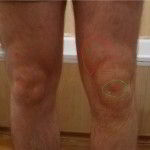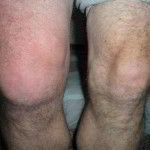Knee bursitis can occur due to injuries, bruises, small wounds and abrasions, as a result of which infections enter the bag of the knee joint. In addition, the disease can appear due to excessive load on the joints, prolonged mechanical irritation of the joints, as well as great physical activity.
Bursitis of the knee joint has the following symptoms:
- Joints become inflamed and severely hurt. Especially when you click on a sore area;
- A diseased joint can hardly move;
- Above the affected joint, the skin reddens and swells;
- Swollen knee increases by 8 – 10 centimeters;
- Muscle weakness appears;
- A person feels weak, cannot work normally;
- Knee bursitis causes an increase in body temperature;
- Knee bursitis usually makes itself felt at night.
If the above symptoms appear, it is important to consult a doctor for timely treatment of the disease.
Features of the treatment of bursitis
Given the symptoms of the disease, the doctor will determine how to treat knee bursitis. But, before starting treatment, it is important to accurately distinguish between bursitis and other diseases, such as arthritis.
Knee bursitis is treated as follows:
- Symptoms of acute bursitis are treated with the help of rest, the use of pressure dressings and warming compresses;
- To prevent purulent bursitis, fixing bandages are used;
- The disease in a chronic form is treated with a puncture to remove exudate and wash the cavity of the bag with an antibiotic and antiseptic;
- Traumatic bursitis is treated with hydrocortisone, which is injected into the synovial joint bag;
- Purulent bursitis can be cured with a puncture. In some situations, specialists are forced to open the bag to remove pus. The treatment of a purulent wound is carried out in accordance with the general rules;
- To dissolve exudate use dry heat, UHF, a bandage with Vishnevsky ointment.
Knee bursitis is also treated this way. The affected joint is fixed with a bandage and kept raised. The main thing is that the knee is constantly at rest.
To relieve inflammation in the knee joint, it is massaged with an ice pack. During the procedure, the joint is covered with tissue. Sometimes a warming ointment helps to quench the pain. Therefore, only an experienced doctor should treat knee bursitis.
In order for the treatment of the disease to be effective, medication is prescribed. To relieve pain, anesthetics are introduced into the affected joint – novocaine with glucocorticoid drugs. If an infection is detected in the synovial bag, a course of antibiotics is given.
After the cessation of pain, it is important to continue treatment until the end of the treatment course, as the doctor prescribed.
The modern method of treating the disease
Radiation therapy procedures will help to cure bursitis. Thanks to this technique, microorganisms that are in the synovial fluid are destroyed. The inflammation is also removed and the normal motor function of the joint is restored. The treatment is carried out by x-ray therapy with different doses of radiation. The dose depends on the severity of the course of the disease and its form. The duration of treatment is not more than three weeks.
Radiation therapy can adversely affect the body. Therefore, before conducting it, you need to think carefully about everything and make the right decision.
Traditional medicine against joint disease
Before starting treatment with folk remedies, it is important to consult a doctor. The doctor, having assessed all the symptoms and condition of the patient, will tell you which unconventional methods will help to defeat the disease in your particular case.
You can treat knee bursitis with the following folk remedies:
- Vegetable compresses. Potatoes, beets or cabbage are cut in circles and spread on a clean cloth, which is applied to the affected joint. A plastic bag and warm cloth are wound on top. In the morning, the compress should be removed. An important point! These vegetables are recommended to alternate until the bursitis is completely recovered;
- Sugar compress. Heat sugar in a dry pan. Pour it into a dense tissue bag and apply to the affected area all night. From above it is also important to warm with cellophane and a warm cloth. Continue treatment until the disease disappears;
- Tea from celery. Fill 15 grams of seeds with boiling water and let it brew for a couple of hours. Strain and drink twice a day for 14 days. A drink will strengthen the body and help relieve inflammation;
- Lotion with propolis. Pour 10 grams of propolis with vodka (150 milliliters) and let it brew for 5 days. After a while, apply lotions to the swellings until they completely resolve.
- Flax seeds put in a bag of chintz and apply to damaged joints. The duration of treatment is two weeks;
- Freeze leaves of Kalanchoe, then repel them and apply to the affected joints. The duration of treatment is one week. After 7 days, the pain will disappear;
- Decoction of burdock root. 15 grams of the plant must be boiled for 5 minutes. Let it brew and compress for a couple of hours for 20 days;
- Mix 100 grams of oil with propolis (15 grams) and take 5 grams daily 60 minutes before meals for 7 days;
- Beat off a leaf of cabbage and attach to a sore joint. Insulate. Compress to do for 7 days;
- Mix grated laundry soap with gruel of onion and honey. Make compresses from the resulting mixture for 14 days;
- Compress from salt. For half a liter of boiling water you need to take a tablespoon of salt. The solution draws fluid from under the skin. Dampen the coarse woolen cloth in the solution, unscrew it and attach it to the swollen knee. On top of a hot compress, wrap the film and a warm scarf or scarf. The procedure lasts 3 to 8 hours. It is carried out once a day until the edema disappears completely. Usually one week is enough to completely get rid of the disease;
- Leaves of a golden mustache. Wash and dry the fresh leaves of the plant. Put them on a damaged knee and wrap them on top with a bag and a warm scarf. You can apply an elastic bandage on top so that the compress does not slip. You can keep it all night;
- Balm against bursitis. Mix pharmacy bile with freshly chopped horse chestnut and aloe leaves. Mix the listed components and fill with alcohol. Put the tincture in a cold place for 14 days. From the finished product, you need to make compresses that satisfy the pain, remove the inflamed fluid from the synovial bag. Thanks to this simple recipe, most patients were able to prevent bursa puncture and exudate pumping;
- 15 grams of St. John’s wort or yarrow pour boiling water and let it brew for several hours. Drink 30 grams three times a day after meals.
It is recommended to massage the joints with olive, eucalyptus, lavender or liquid paraffin. Hay baths are also useful. The described non-traditional methods of treating bursitis help to cope with the disease, but only in parallel with the medication prescribed by the doctor. The most important thing is not to self-medicate, so as not to aggravate the situation.
Bursitis Prevention
To bursitis of the knee joint did not make itself felt it is recommended to follow these tips:
- Keep track of the correct joint stress;
- Handle any skin lesions well;
- Take ulcer diseases seriously. Treat them immediately after detection;
- Athletes are advised to protect the joints with special knee pads and try not to overload them during sports;
- Before performing any physical exertion, it is important to do the right workout first;
- After physical education, be sure to do special exercises to complete classes.
Now you know about the treatment of bursitis of the knee joint. What reasons provoke its development, what symptoms does it have, and also how is the medical treatment of the disease and treatment with folk remedies carried out. Despite the treatment you have chosen – folk or medication, remember that you need to consult a doctor to protect your health.







